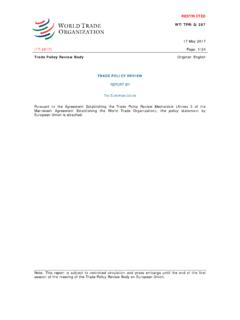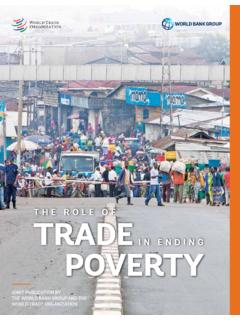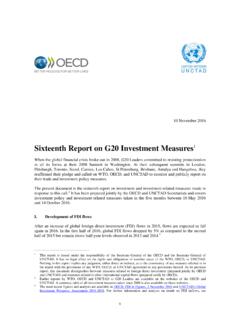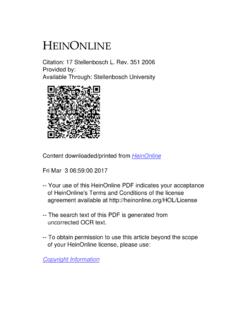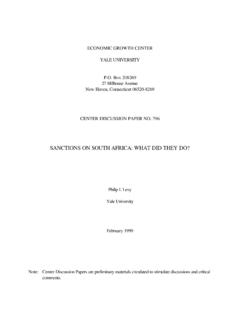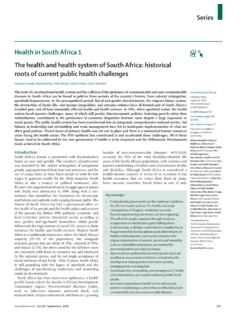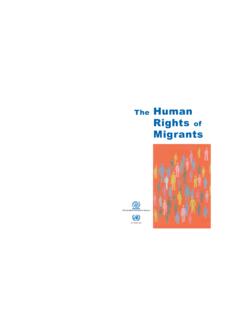Transcription of Regional Integration in Africa
1 Staff Working Paper ERSD-2011-14 Date: October 2011 World Trade Organization Economic Research and Statistics Division Regional Integration in Africa Trudi Hartzenberg Trade Law Centre for Southern Africa (tralac) Manuscript date: October 2011 Disclaimer: This is a working paper, and hence it represents research in progress. This paper represents the opinions of the author, and is the product of professional research. It is not meant to represent the position or opinions of the WTO or its Members, nor the official position of any staff members. Any errors are the fault of the author. Copies of working papers can be requested from the divisional secretariat by writing to: Economic Research and Statistics Division, World Trade Organization, Rue de Lausanne 154, CH 1211 Geneva 21, Switzerland. Please request papers by number and title.
2 1 Regional Integration in Africa Trudi Hartzenberg Trade Law Centre for Southern Africa (tralac) Abstract: This paper examines the history of Regional Integration in Africa , what has motivated it, the different initiatives that African governments have pursued, the nature of the Integration process, and the current challenges. Regional Integration is seen as a rational response to the difficulties faced by a continent with many small national markets and landlocked countries. As a result, African governments have concluded a very large number of Regional Integration arrangements, several of which have significant membership overlap. While characterized by ambitious targets, they have a dismally poor implementation record. Part of the problem may lie in the paradigm of linear market Integration , marked by stepwise Integration of goods, labour and capital markets, and eventually monetary and fiscal Integration .
3 This tends to focus on border measures such as the import tariff. However, supply-side constraints may be more important. A deeper Integration agenda that includes services, investment, competition policy and other behind-the-border issues can address the national-level supply-side constraints far more effectively than an agenda which focuses almost exclusively on border measures. Keywords: F15, O19 JEL Classifications: Regional Integration 2 1. Introduction There is much support from African governments for Regional Integration . Indeed since independence they have embraced Regional Integration as an important component of their development strategies and concluded a very large number of Regional Integration arrangements (RIAs), several of which have significant membership overlap. There are however few success stories.
4 African RIAs are generally ambitious schemes with unrealistic time frames towards deeper integration1 and in some cases even political union. African2 RIAs are usually neighbourhood arrangements. Traditionally, the European Union was Africa s most important trade, investment and development partner. Trade with the EU was governed by a series of Lom Conventions, which granted African countries (excluding south Africa ) unilateral preferential access to EU markets. The EU and African countries concluded the Cotonou Agreement which paved the way for the negotiation of World Trade Organisation (WTO) compatible Economic Partnership Agreements, in 2000. Various configurations of African countries have constituted negotiating groups; many of which however cut across existing neighbourhood Regional Integration arrangements, adding an additional layer of complexity to the Regional Integration process in Africa .
5 The protracted and difficult EPA negotiations reflect to some extent the difference between the African paradigm of Regional Integration and the EU s model of Regional trade agreements, but also the challenges of African Regional Integration . The EPA negotiations revealed important gaps between political ambitions and economic reality in African Regional Integration . Debates about the African Integration agenda and indeed Africa s strategy for Integration into the global economy are emerging from these negotiations, which are still ongoing. The African paradigm is that of linear market Integration , following stepwise Integration of goods, labour and capital markets, and eventually monetary and fiscal Integration . The starting point is usually a free trade area, followed by a customs union, a common market, and then the Integration of monetary and fiscal matters to establish an economic union.
6 The achievement of a political union, features as the ultimate objective in many African RIAs. This process is 1 Reference to deeper Integration in the context of African Regional Integration usually means progress from a free trade area to a customs union and beyond to eventual political union. This contrasts with the use of the term deeper Integration to refer to the inclusion of behind the border issues such as services, investment and competition policy on the Regional Integration agenda. Both are used in this paper the appropriate distinction being noted when the term is used. 2 African Integration in this paper refers by and large to the experience of Sub-Saharan Africa , although brief reference is made to the Arab Maghreb Union as one of the building blocks of the African Economic Community 3 followed by the various Regional economic communities (RECs) in Africa and at a Pan African level, eight of the RECs have been identified as the building blocks of the African Economic It is accepted in this paper that Regional Integration makes sense for Africa ; a continent characterised by small countries, small economies and small markets.
7 What is at issue, however, is whether the linear model of Regional Integration currently, defining the African Integration paradigm, makes sense for the continent. 2. Africa : a Marginalised and Fragmented Continent4 Africa continues to engage at the periphery of the global economy, as is evident from the continent s declining share in global production and trade. The majority of sub-Saharan Africa s (SSA) 47 countries are small and least developed, according to UNCTAD s definition. (UNCTAD, 2007). Most of Africa s countries have low per capita income levels and small populations which result in small markets. In 2008, 12 SSA states had populations of less than 2 million while 19 had a gross domestic product (GDP) of less than US$5 billion, six of which had a GDP of less than US$1 billion. Not only are most SSA economies small and poor, but 15 are also landlocked, an important contributory factor to high trade transaction costs, and more generally to the high costs of doing business in Africa .
8 In addition to border barriers, many other constraints exist, increasing the transaction costs of trade. Geography is an important consideration. Low per capita densities of rail and road transport infrastructure, which in colonial times was designed to transport primary products to port. Poorly developed cross-country connections are the outcome (McCord et al., 2005: 37). It has been pointed out that the reality on the ground is that transport costs in Africa are still among the world s highest. For example, shipping a car from Japan to Abidjan costs US$1 500 (including insurance); shipping that same car from Addis Ababa to Abidjan would cost US$5 000. Throughout the continent, many road, air, and rail networks remain unconnected 3 It is noteworthy that the Southern African Customs Union, the oldest functioning customs union, is not one of the recognized building blocks of the African Economic Community.
9 4 This section of the paper draws on McCarthy 2007 and McCarthy 2010. 4 (Economic Commission for Africa , 2004: 2). Furthermore, cost inefficiency, and the lack of competition in air transport because of regulatory policies, result in high costs of air travel. Overall, the high cost and unreliability of transport services contribute to a high-cost business environment in which firms are forced to keep higher levels of inventories, which means that cost-saving management systems of just in time production cannot be used (Collier, 2000). The lack of skills and capital to establish and operate sophisticated modern communication systems, combined with small business communities that do not allow financially viable business publications, mean that business news and information required for informed decision making is another important constraint.
10 Fixed-line telephone services are limited and unreliable, with notoriously high call charges, especially for international calls. In most African economies, the provision of fixed line phone services is still the exclusively in the hands of public monopolies. Contracts require information on comparative prices and depend on reliable, fast, and low-cost access to reliable market information, including information on the credit worthiness of potential clients. Information is essential to facilitate efficient market outcomes, and lack of readily available information at reasonable cost will hamper market efficiency as a result of high or hidden trade transaction costs. The geo-political configuration of Africa has been largely determined by the continent s European colonial powers, and as such has little to do with the emergence of nation states.




